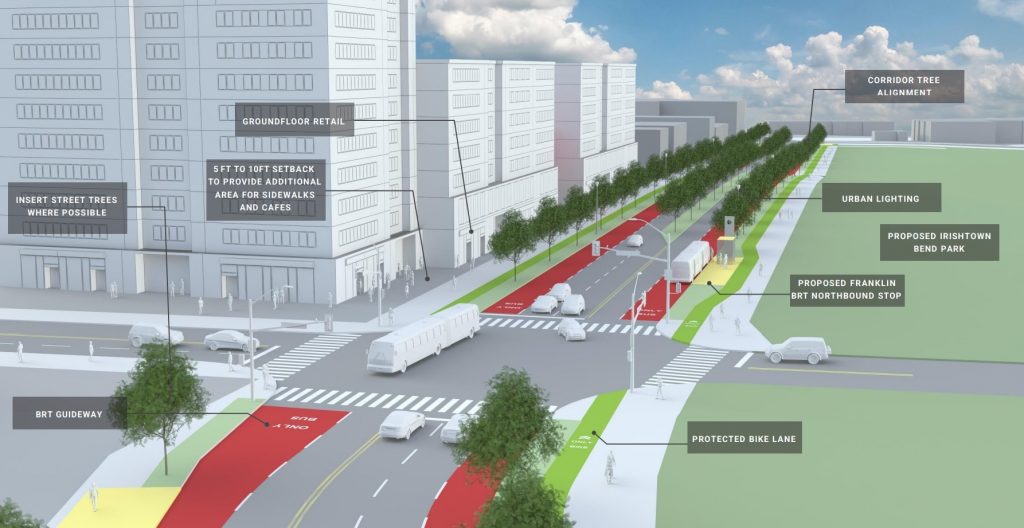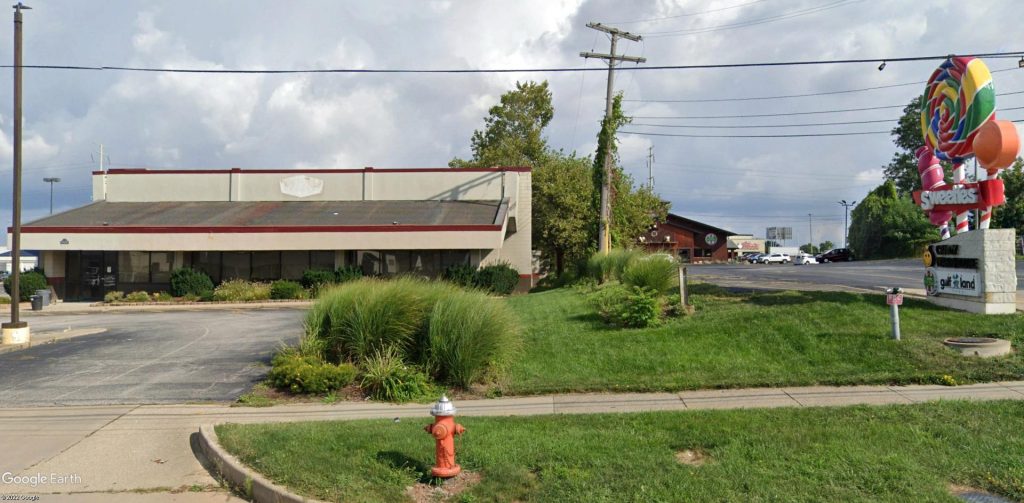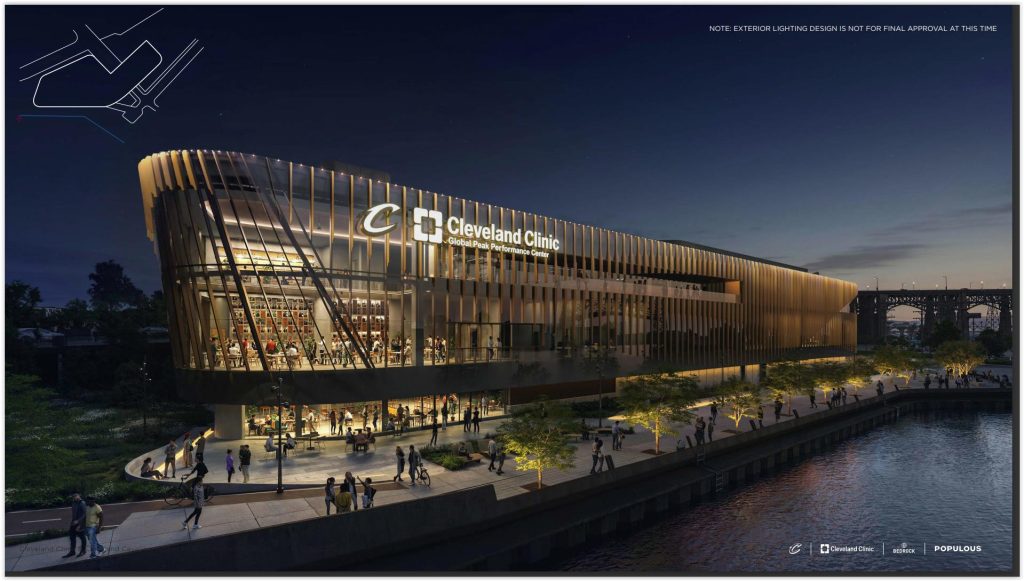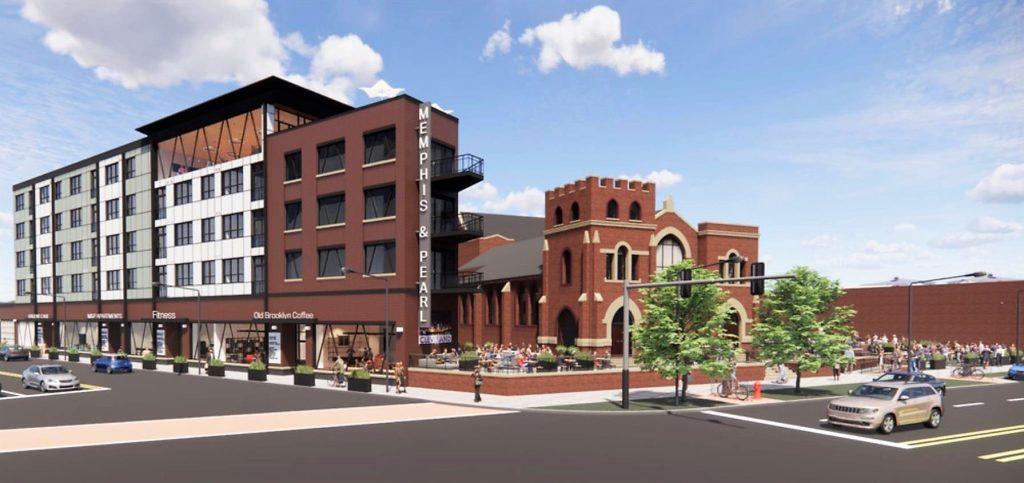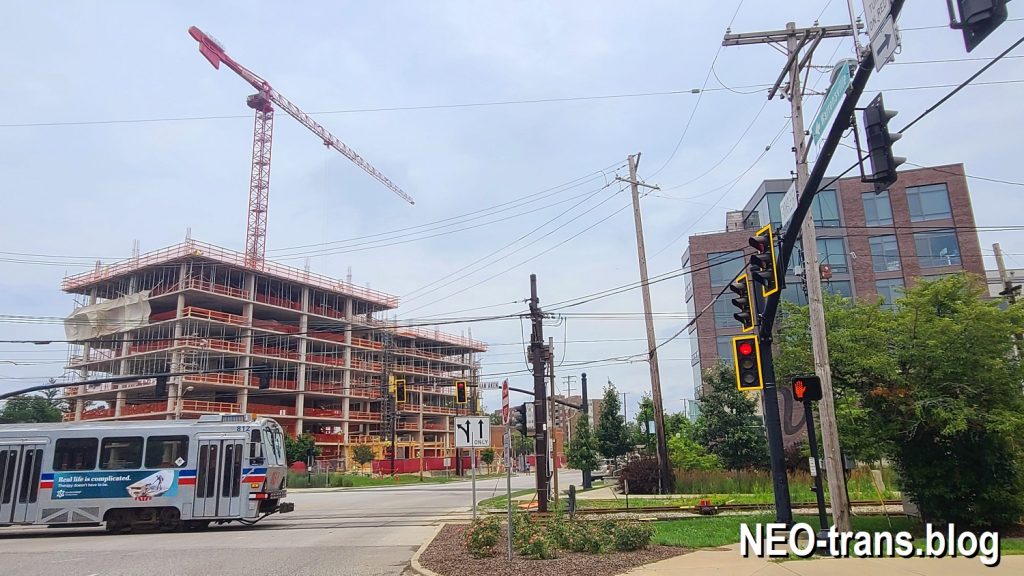
Construction is moving along on the high-rise Farnsleigh Apartments at the Van Aken District in Shaker Heights at the end of the light-rail Blue Line. Many housing developments are planned at or near rail and bus rapid transit stations in Greater Cleveland to address a housing shortage but tight lending and high interest rates have slowed the start of new projects. New guidance for existing federal financing could free up new lending. (KJP). CLICK IMAGES TO ENLARGE THEM.
Empty office buildings, station lots offer opportunity
Having too much office space, not enough housing inventory and tight private financing to address those conditions isn’t just a Greater Cleveland phenomenon. It’s a nationwide problem. So the federal government on Friday announced incentives to encourage the conversion of high-vacancy commercial buildings to residential use and develop surplus land owned by transit agencies.
The incentives include new or expanded below-market-rate financing, technical assistance, and the sale of federal properties. These incentives are intended to create much-needed housing that is affordable, energy efficient, near transit and jobs, and reduce greenhouse gas emissions. Multiple projects in Greater Cleveland might be eligible to benefit from these incentives, be they office-to-residential conversions or new construction projects near transit and on surplus transit-owned land.
In Greater Cleveland and across the country, an increase in remote working since the pandemic has caused office and commercial vacancies which are affecting downtowns and suburban main streets. A new blog released today by the Council of Economic Advisers finds that office vacancies have reached a 30-year high, placing a strain on commercial real estate and local economies. That strain extends to transit agencies like the Greater Cleveland Regional Transit Authority (GCRTA) which has seen commuting on its rail system into Downtown Cleveland drop by as much as 80 percent since before the pandemic, leaving park-n-ride lots at stations mostly empty.
At the same time, there is a shortage of for-sale and rental housing in Greater Cleveland and nationwide. The nation has struggled for decades with a shortage of affordable housing units, a situation that has worsened as Baby Boomers retire and seek low-maintenance housing. That shortage is driving up rental costs, and communities are seeking new ways to cut emissions, especially from existing buildings and transportation. High interest rates are slowing lending be it for single-family home sales or for financing new multifamily construction projects.
The Biden Administration announced that the U.S. Department of Transportation (DOT) is releasing new guidance to states, localities and developers on tapping its existing Transportation Infrastructure Finance and Innovation Act (TIFIA) and Railroad Rehabilitation & Improvement Financing (RRIF) programs. Combined, they have over $35 billion in available lending capacity for transit-oriented development (TOD) projects at below-market interest rates. They can be used to finance housing development near public transportation, including conversion projects. Those programs typically lend at treasury interest rates which are 2-3 percentage points below market rates.
Eligible projects can be located within a half-mile of fixed-guideway (rail or bus rapid transit) public transportation routes. Greater Cleveland has an increasing number of such routes, starting with GCRTA’s 36-mile, three-route rail system. Those rail transit lines include the Airport-Downtown-Windermere Red Line, the Waterfront-Shaker Heights (Green Road) Green Line and the Waterfront-Shaker Heights (Warrensville) Blue Line.
GCRTA also has the dedicated-lane HealthLine Bus Rapid Transit (BRT) on Euclid Avenue from Public Square to Windermere and the Cleveland State Line BRT-lite on Clifton Boulevard in Lakewood and Cleveland’s Edgewater neighborhood. GCRTA is planning two other BRT-lite routes — the MetroHealth Line along West 25th Street from Detroit Avenue south to Old Brooklyn. This $48.5 million project has nearly half the funding in hand for new infrastructure and buses. TOD land use planning is being developed along this transit corridor and, more recently, along the Broadway-Slavic Village corridor from downtown to the the Turney-Ella bus loop near Calvary Cemetery.
In addition, DOT released a policy statement with principles for pursuing transportation projects with the dual goals of increasing affordable housing supply and decreasing emissions. By making low-cost financing available for conversions and housing projects near public transportation, this guidance and policy statement will increase housing supply, while encouraging state and local governments to improve their zoning, land use, and TOD policies.
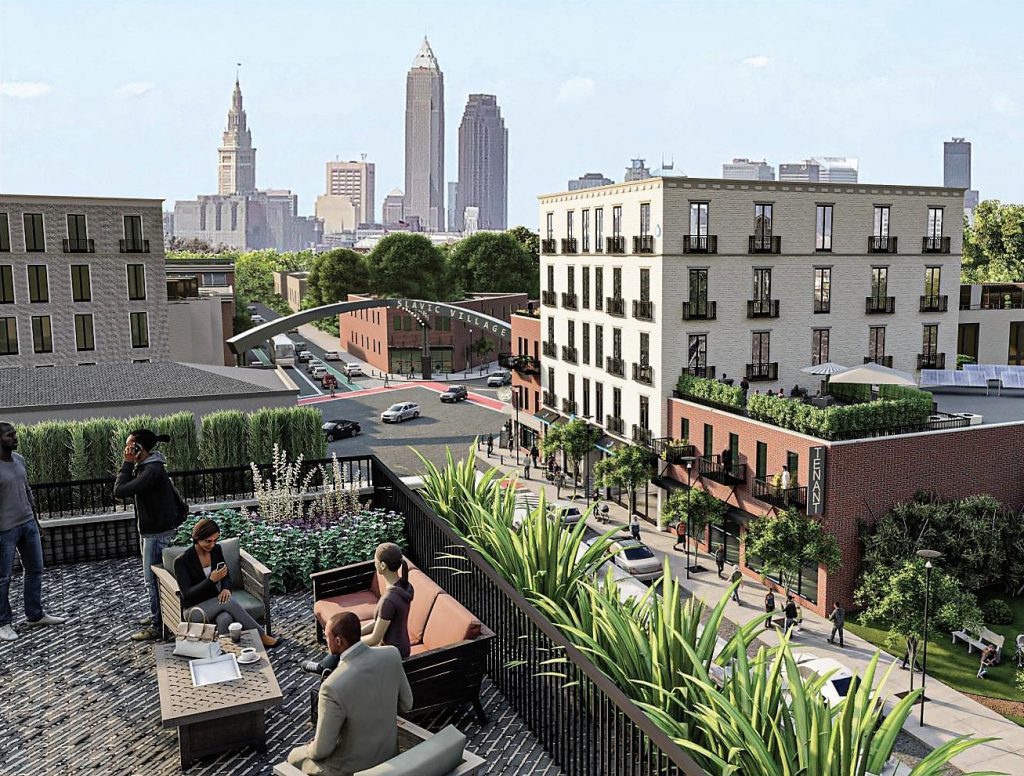
The busy transit corridor of Broadway Avenue at East 55th Street in Cleveland’s Slavic Village is proposed to be redeveloped with new and renovated buildings, including The Atlas Building from which this view is portrayed. The new white building at right is proposed to be The Village 55 with apartments over commercial space (VEDA).
DOT is releasing guidance that makes it easier for transit agencies to repurpose properties for TOD and affordable housing projects, including conversions near transit. Under the new guidance, transit agencies may transfer properties to local governments, non-profit, and for-profit developers of affordable housing at no cost. The new policy has the potential to turn property no longer needed for transit, such as the vacant parking lots at GCRTA train stations, into affordable housing development particularly when combined with loans from TIFIA or RRIF programs.
The U.S. Department of Housing and Urban Development (HUD) is releasing an updated notice on how the Community Development Block Grant (CDBG) fund, $10 billion of which have been allocated during the Biden Administration, can be used to boost housing supply. That includes the acquisition, rehabilitation and conversion of commercial properties to residential uses and mixed-use development. HUD is also increasing outreach efforts to support municipalities and developers seeking to use HUD tools to finance conversions.
States and localities can also access up to five times their annual CDBG allocation in low-cost loan guarantees to fund projects such as the conversion of properties to housing or mixed-use development. In addition, HUD will make awards through a research-related Notice of Funding Opportunity, which can be used to develop case studies that can serve as roadmaps for other localities interested in pursuing conversions. HUD is also accepting applications for the $85 million Pathways to Removing Obstacles to Housing program, which includes the development of adaptive reuse strategies and the financing of conversions as eligible activities.
In Greater Cleveland, office-to-residential conversions that might be eligible for these incentives include the redevelopment of the Centennial, 925 Euclid Ave., or the to-be-vacated Landmark Building, 101 W. Prospect Ave. According to real estate insiders, both properties were submitted by their owners as new-site candidates for the Cuyahoga County courthouse. The deadline for submitting courthouse proposals to the county was Oct. 26.
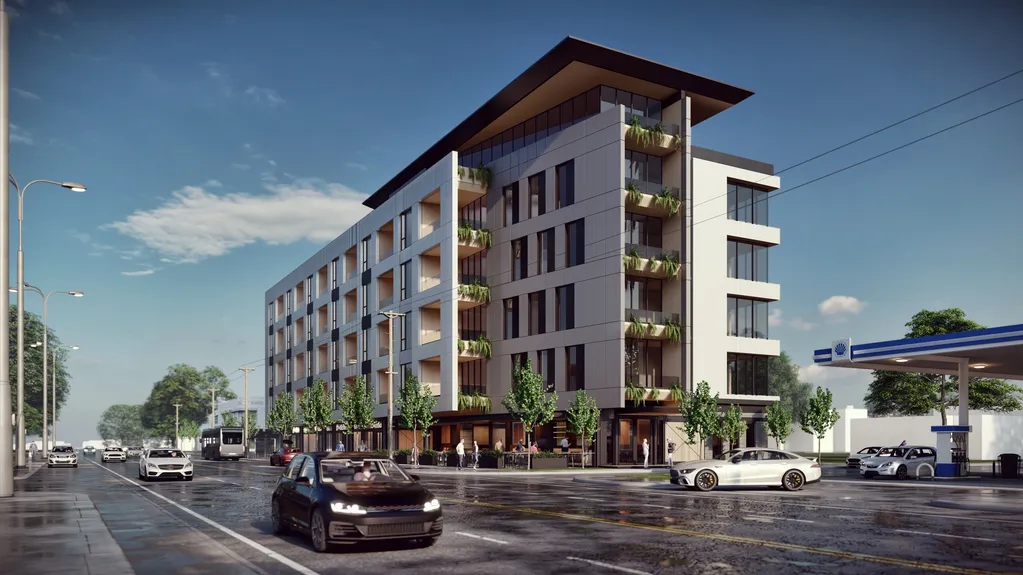
Genesis Global Holdings LLC of New York City proposes to redevelop with mixed uses the Cuyahoga County’s abandoned East Cleveland Adult Activity Center and its 4.25 acres of land located between the Superior station on the Red Line and the Emily Street stop on the HealthLine (GGH).
Eligible new construction projects within a half-mile of Cleveland rail and BRT routes are numerous. Downtown, they could include lakefront developments, Bedrock’s riverfront developments, Flats East Bank’s next phase, the Samsel redevelopment and Playhouse Square-area projects. On the West Side, they could include Bridgeworks, Lutheran Lofts, or Intro phase two in Ohio City, Hub 27, APL Apartments and Townhomes, or West 20th Apartments in Tremont, developments across West25th from MetroHealth Medical Center, or the Westinghouse redevelopment, Shoreway Tower and 8400 Lake near Edgewater Park.
On the East Side, eligible projects could include several Midtown developments, The Village 55 in Slavic Village, the Genesis development and the Circle East neighborhood in East Cleveland, East 79th Street-area housing, Woodhill Station East, Shaker Square developments under new owners, and the next steps in the Van Aken District in Shaker Heights.
GCRTA is also seeking to make use of surplus properties it owns. It has an agreement with Flaherty & Collins Development LLC of Indianapolis to sell 1.3 acres of land it no longer needs just west of the West Boulevard-Cudell Red Line rail station for a 60-unit apartment building called the Depot On Detroit. A similar effort could occur at the Ohio City Red Line station, too.
However, a NEOtrans analysis in August showed that’s just the tip of the iceberg. The amount of GCRTA-owned land devoted to vastly underutilized parking lots at its rail stations total 30 acres, and all GCRTA properties at those stations total 80 acres. Among all GCRTA, adjacent public and underutilized private properties, they total 232 acres. Developed with transit-supportive housing at 30 units per acre, an average household size of 2.4 persons and an average retail square footage of 23.5 square feet per person, all of those stations could host a total of 5,800 to 8,120 housing units for 13,920 to 19,488 people with 327,120 to 457,968 square feet of neighborhood retail.
END

